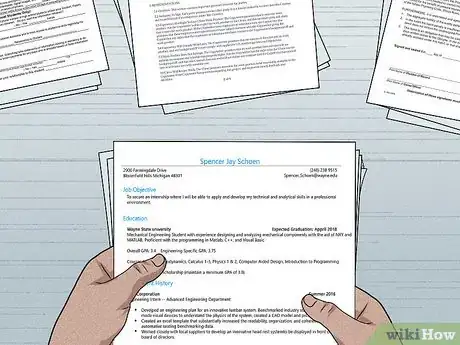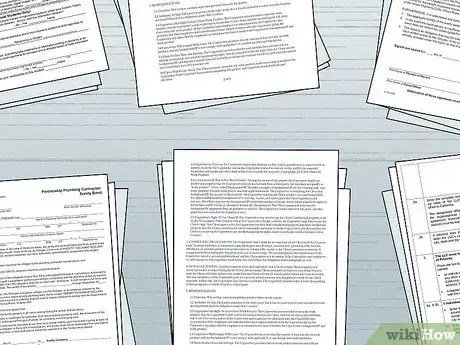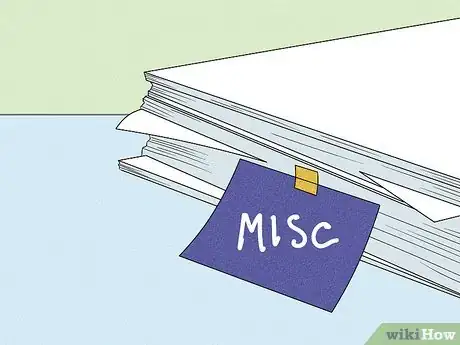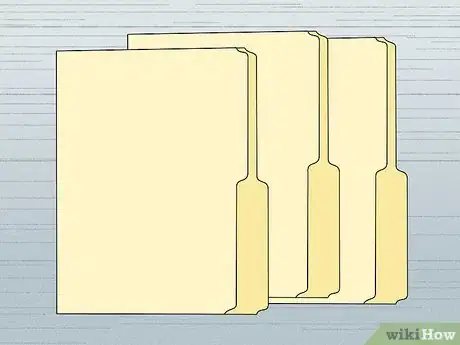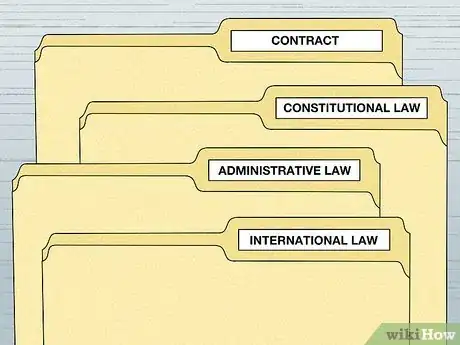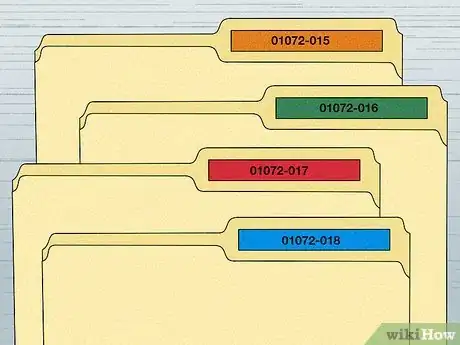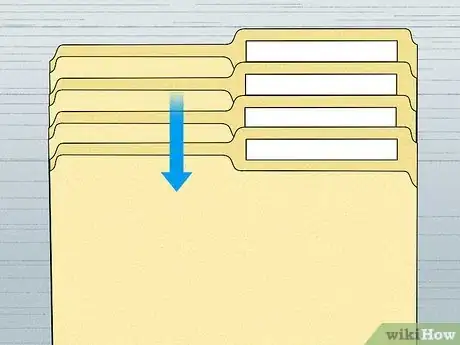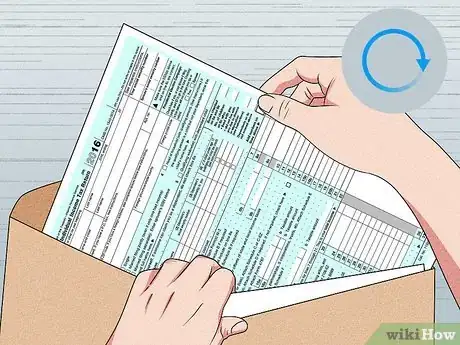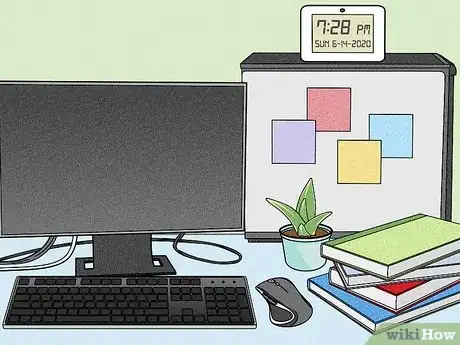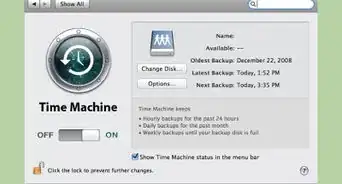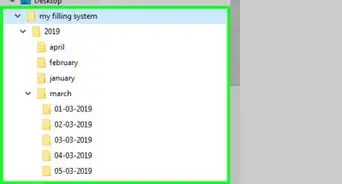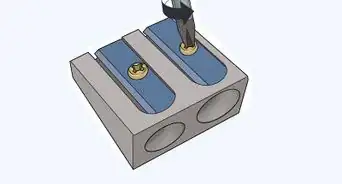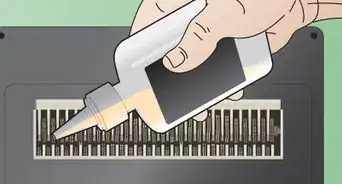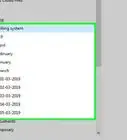This article was co-authored by Christel Ferguson. Christel Ferguson is the owner of Space to Love, a decluttering and organization service. Christel is certified in Advanced Feng Shui for Architecture, Interior Design & Landscape and has been a member of the Los Angeles chapter of the National Association of Productivity & Organizing Professionals (NAPO) for over five years.
wikiHow marks an article as reader-approved once it receives enough positive feedback. In this case, 100% of readers who voted found the article helpful, earning it our reader-approved status.
This article has been viewed 196,000 times.
If you’re in business or school that requires you to work with multiple clients or projects, a proper filing system is critical. There are several methods for filing papers, but ultimately your system should reflect your needs. The best way to prepare for an efficient system is to reserve a couple days to solely work on organization.
Steps
Preparing for a New Filing System
-
1Gather all your materials. You need to compile all your paperwork before attempting to setup a proper system. Go through all locations you may have paperwork and place them all in one pile. Spend time to make sure you can properly account for all active and inactive work you have.
- Plan ahead of time by clearing a table space to work on your papers.
- If you are adapting someone else’s paperwork into a new filing system, remove all documents from the current system. It will be better for you to handle all documents and prepare for a new system.
-
2Go through all the documents. This is the hard part of the process, but it is also a crucial step to becoming organized. Separate all of the files based on what they are, such as bank statements, credit card bills, and mortgage payments.[1] It may seem tedious, but go through each document in your pile to determine what you’re working with.
- You don’t need to read each paper, but a brief skim will help you out.
- Post-it notes are good for marking important papers you know you’ll need to spend time on.
Advertisement -
3Set up piles. As you start to sort through your paperwork, it would be helpful to keep related papers together. You could place all papers relating to the “Nickelback” client in one pile. Another example is to pile your work based on months.
- Having a sense of chronological order could be useful for your filing needs.
- Set priorities while sorting through paperwork. When you see papers that are exceptionally important, place them on the top of their respective pile.
-
4Reduce as you see fit. Another pile you can create is the trash pile. You aren’t required to throw away a pile of your paperwork, but you should separate the unimportant papers from the other piles.[2] You could even set up a miscellaneous pile where random papers could go.
- If you are 100% sure that you don’t need some paperwork and you cannot draw a viable link to other document, discard them. Check with your superiors if you’re allowed to throw away anything before following through with something.
-
5Use manila folders. Keep things simple for yourself by using cheap manila folders.[3] This won’t hurt your funds and will allow you to carry out any filing system you’d like. You can get a pack of manila folders from any office supply store.
-
6Transfer your piles. Use the piles you established earlier to act as a guide for your folders. Ensure that the contents of each folder are organized as well. You can either organize a file’s contents based on each paper’s importance or by chronology.
- Avoid arranging a file’s contents based off the alphabet. Alphabetical organization works more efficiently for organizing groups of files.
- Place the manila folders into a filing cabinet as you fill the folders.[4]
Creating a System Fit for You
-
1Use an alphabetical filing system. An alphabetical filing system works well when you need to retrieve names of people, customers, authors, names of movies, books, or etc. Provided you use terms that are easy to retrieve, an alphabetical filing system is often the easiest system to use.[5]
- The best way to file and retrieve files is by labeling each file. Manila folders have an extra tab designed to label files that will make your retrieval process easier.
- If you are handling clients, it is more efficient to alphabetize by last name.
- If you have a lot of files, consider making letter sections to help you organize. Section dividers are large and simply contain one letter. You can also divide the letters in pairs like “A-D” or “F-K.”
-
2Use a topical order. When you work or study in a variety of subject areas, a subject or topic order can be a very useful way to retrieve information. For example, if you study law, you could have subject headings of contract, constitutional law, torts, administrative law, international law etc.
- The best way to organize topical information is through section dividers. Label your section dividers based off the contents, like “Admin Law.”
- This system works best if you have several different topics. If not, you’ll be left with one or two dividers and not much of an organized system.
-
3Try numerical filing. This type of filing system is ideal for files that contain dates or numbers. For example, if you have invoices, receipts, dated events etc., the numerical system can make an easy system to locate again. You can also consider month and year labeling for this option. For those working in an environment that uses numbering for papers such as medical files, legislative documents, court cases, etc., numbering is a useful retrieval method.
- Only use this system if you are comfortable viewing several numbers and can retrieve information from these numbers.
- Mark on the filing tabs the numbers or dates and organize based off the numbered value. Start with “1” and have the following numbers increase value.
- If you are filing with months, start with January and move, in order, through December. You’ll benefit with section dividers for each month.
-
4Use color coding. This is great for creative filing and is especially effective for those with good visual recall. It can help to cross-reference different subjects based off color coding. You can color code any of the aforementioned techniques for filing.[6] You can also use a combination of organizing systems by pairing color codes with another system.
- One of easiest ways to add color to your established filling method is by using highlighters. You can purchase a variety pack of highlighters from any office supplies store.
- Another way to implement color coding is by using a variety of colored folders.
-
5Use a frequency system. This works well for items that you use all the time, but shouldn’t be a standalone system. It needs to feed off another system, for example the alphabetical system. Add the frequently used information to a grouped space in your filing area so that it can be retrieved quickly, such as at the very front of a filing cabinet drawer.[7]
- You’ll need to be careful you don’t get unorganized using this system. Keeping the project you’re currently working on in the front, won’t always guarantee an efficient organization.
Retaining an Organized System
-
1File paperwork immediately. One way to ensure your filing system runs efficiently is by filing paper as you process it.[8] The filing system is not going to work if you put off filing papers. Getting into the habit of filing papers will also help your productivity and workflow.
-
2Keep your space updated. Every couple of months you should go through your filing system and do a brief sweep. You aren’t required to review all your papers like you did for the initial organization. Check through all files and make sure everything is organized and in the right place.
- After the first few months you could also reflect if the system you choose is working for you.
-
3Clean out your space. Once a year you should do a larger cleaning of your workspace. You might have some files that you regularly use, but you should now go through the other files you use less.[9] Open the files you use less and read through all your documents to see if there is any unnecessary paperwork.
- Take out all the files and wipe down the filing cabinet with a damp washcloth to remove dust buildup.
Expert Q&A
-
QuestionWhat is a good filing system?
 Christel FergusonChristel Ferguson is the owner of Space to Love, a decluttering and organization service. Christel is certified in Advanced Feng Shui for Architecture, Interior Design & Landscape and has been a member of the Los Angeles chapter of the National Association of Productivity & Organizing Professionals (NAPO) for over five years.
Christel FergusonChristel Ferguson is the owner of Space to Love, a decluttering and organization service. Christel is certified in Advanced Feng Shui for Architecture, Interior Design & Landscape and has been a member of the Los Angeles chapter of the National Association of Productivity & Organizing Professionals (NAPO) for over five years.
Professional Organizer Store folders with "memorabilia," like old assignments and keepsakes, somewhere other than your new filing system since you don't have to regularly reference them.
Store folders with "memorabilia," like old assignments and keepsakes, somewhere other than your new filing system since you don't have to regularly reference them. -
QuestionShould the latest-dated file be placed at the front of the file, or placed at the bottom?
 Community AnswerThe latest-dated file, such as the newest invoice, p.o., or bill, always goes in the front of the file.
Community AnswerThe latest-dated file, such as the newest invoice, p.o., or bill, always goes in the front of the file. -
QuestionWhat are standard guidelines for filing by last name?File alphabetically by the first letter of the last name. If you have several files with the same last name, then sort them by first name within that group. For example: Smith, Ann; Smith, Bill; Smith, Bob. If you have two people with the same first and last name, then use the middle name to sort. For example: Smith, Bill P.; Smith, Bill X.
Things You'll Need
- Filing tabs
- Filing folders (hanging folders)
- Filing cabinet or other suitable holder for files
References
- ↑ Christel Ferguson. Professional Organizer. Expert Interview. 17 December 2018.
- ↑ Christel Ferguson. Professional Organizer. Expert Interview. 17 December 2018.
- ↑ Christel Ferguson. Professional Organizer. Expert Interview. 17 December 2018.
- ↑ http://www.smead.com/hot-topics/filing-system-1396.asp
- ↑ http://zenhabits.net/how-to-simplify-your-filing-system-or-why-stacking-just-doesnt-work/
- ↑ http://www.smead.com/hot-topics/filing-system-1396.asp
- ↑ http://zenhabits.net/how-to-simplify-your-filing-system-or-why-stacking-just-doesnt-work/
- ↑ http://zenhabits.net/how-to-simplify-your-filing-system-or-why-stacking-just-doesnt-work/
- ↑ http://zenhabits.net/how-to-simplify-your-filing-system-or-why-stacking-just-doesnt-work/
About This Article
How you arrange your paper filing system will depend on what you use it for. If you work with a lot of different clients or customers, an alphabetical system might be best for you. If you work with many different subject areas, consider arranging your paperwork by topics. For instance, if you study law, separate your papers into contract law, constitutional law, international law, and so on. You can also color code your files to make them easier to locate and coordinate. Alternatively, if you’re always looking things up by date or you need to easily find invoice numbers, try a numerical system. Depending on how much paperwork you have, you might need to use several different filing systems to organize different kinds of documents. For more tips from our Organizational co-author, including how to maintain your organized filing system, read on!

